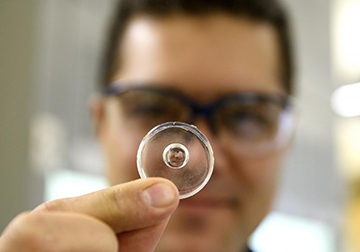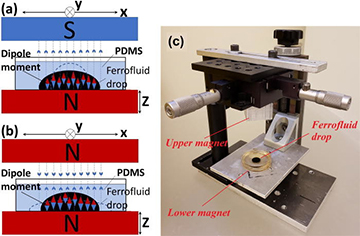
The first author on the study, Washington State grad student Mojtaba Falahati, holds one of the lenses fabricated by the method. [Image: WSU]
Plastic lenses have made increasing inroads in optical devices, for good reason—they’re lightweight, low in cost and versatile, and sport optical properties suitable for many applications. A big part of the cost equation for some plastic lenses, though, lies in the expensive molds and associated equipment needed in their manufacture. That stacks the deck in favor of high-volume production, and against using molds to make low-volume or customized plastic lens designs.
A research team from two U.S. universities has developed a clever, low-cost alternative approach for creating one particular variety of plastic lenses—plano-concave lenses (Appl. Phys. Lett., doi: 10.1063/1.5090511). Instead of fashioning sophisticated or expensive molds, the team’s method uses a magnetically controllable droplet of ferrofluid to shape the surrounding resin and create the lens. The researchers believe that the approach—which they describe as “low cost, rapid and straightforward”—could prove particularly useful in developing lenses for low-volume purposes, such as quickly making and testing lenses of varying sizes and shapes.
Born of necessity
The team, including engineering researchers from Washington State University and Ohio State University, focused on the problem of making lenses using polydimethylsiloxane (PDMS), a strong candidate for multiple optical applications owing to its good transparency, biocompatibility and flexibility. Such lenses are most commonly manufactured in high volume using molding techniques, though some groups have developed alternative niche manufacturing approaches employing lithography, laser engraving and other methods.
The Washington State–Ohio State researchers were interested specifically in creating lenses for a smartphone-based lab device they were developing, but wanted to avoid the cost and complexities of commercially molded lenses. After some unsuccessful attempts to 3-D-print the lenses they needed in the lab, they hit upon the idea of creating a liquid mold that could be controlled magnetically.
Adjustable blob
The heart of the system lies in a drop of fluid—in this case, a commercially available water-based ferrofluid impregnated with superparamagnetic nanoparticles. The researchers placed a drop of the fluid in a petri dish on a layer of uncured, liquid PDMS resin. Because the two liquids have different levels of hydrophilicity, the PDMS and the ferromagnetic droplet don’t intermix, but remain entirely separate, with the lower-density ferrofluid initially sitting on top of the resin.

The shape of the ferrofluid droplet was controllable by whether the magnets were set to attract (top left) or repel (bottom left) one another, as well as by the distance between the two magnets, which could be tweaked using the lab’s homebuilt device (right). [Image: Reprinted from M. Falahati et al., Appl. Phys. Lett. 114, 203701, doi: 10.1063/1.5090511, with the permission of AIP Publishing]
Next, the team put the petri dish on the stage of a homebuilt apparatus kitted out with rare-earth neodymium cylindrical magnets both above and below the sample. The upper magnets could be flipped to allow for magnetic attraction or repulsion, depending on the configuration.
When the lower magnet was placed below the petri dish, creating an attractive force, the ferrofluid droplet was dragged down through the resin to rest at the bottom of the dish, forming a lenslike blob beneath the overlying resin. The team found that, by adjusting the distance between the upper and lower magnets, and the orientation of the upper magnet, it could control the shape of the blob of ferrofluid at the base of the plastic—effectively turning the blob into a free-flowing, magnetically controllable mold.
Once the right shape had been formed by adjusting the magnets, the researcher put the entire apparatus into an oven to cure the plastic resin at 75 °C for 40 minutes. When the curing was done, the result was a hard plastic slab with a controlled concave curvature on the bottom and a flat surface on the top—a plano-concave lens. The water-based ferrofluid dropped off of the lens and could be reused in making the next one.
Cranking out different lenses
The team used the setup to quickly create a variety of plano-concave lenses with numerous different profiles, ranging from flattened models with the upper magnet configured to provide a repelling force to sharper, more conical profiles when the upper magnet was set to attract. The concentration of magnetic nanoparticles in the ferrofluid provided another useful control knob for adjusting lens shape. And the researchers could create lenses of varying sizes simply by changing the volume of the ferrofluid. Tests with a negative USAF target pattern suggested that the PDMS lenses molded using the method “had comparable performance” to a commercial lens.
The engineers plan to move the project forward by more completely characterizing the interactions between the polymer and the ferrofluid at the interface, and by developing “an explicit relationship” between the parameters in the experiment that would tie together lens profile, magnetic field, droplet volume and other parameters. Meanwhile, the researchers view the technique as “suitable for rapid production of low-volume and customized” lens designs without resorting to expensive molding and casting processes.
